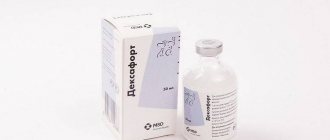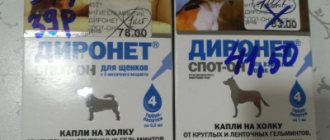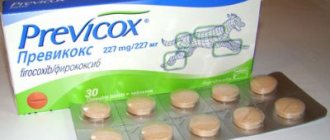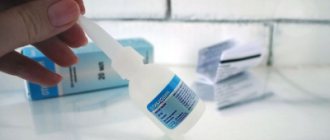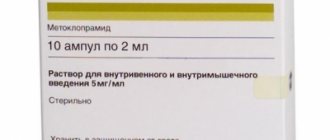Globcan 5 is a therapeutic and preventive serum that includes highly purified globulin fractions isolated from hyperimmune animals such as horses or sheep. Immunoglobulin is active against pathogens of certain infections.
The serum demonstrates the greatest therapeutic effect when used during the incubation or prodromal stage. When using serum for preventive purposes for dogs, they develop passive immunity for approximately 2 weeks.
Purpose
The vaccine is used in the initial stage of a viral disease or for prophylactic purposes against canine distemper, parvo- and coronavirus enteritis in puppies, and other viral infections. These diseases pose the greatest danger to puppies and young dogs during the period of active growth and formation of the immune system.
Distemper in dogs
One of the most dangerous diseases, especially for small puppies, is distemper. This viral infectious disease has a high mortality rate among puppies under one year of age and weakened animals, although healthy, strong adult dogs are not protected from infection.
The virus multiplies very quickly, causes severe intoxication of the body and is capable of infecting several systems at once. It is resilient and remains active even in an unfavorable environment; it dies at a temperature of + 45 degrees Celsius after two weeks, and only heating to + 60 degrees can kill it within half an hour. Disinfectants also do not help: to neutralize the distemper virus, it takes up to three hours of constant exposure to disinfecting solutions.
Important!
It is believed that some dog breeds are more prone to the disease than others. The risk group includes poodles, huskies, Pekingese, and German shepherds.
Treating distemper is very difficult, especially if the disease is not identified at the earliest stage, and a pet can become infected directly from a sick animal (or a carrier of the virus) or indirectly - when the virus is brought into the house on clothes, shoes by the puppy’s owner, as well as through contact with objects , which were used by a sick dog. Sometimes it is enough for a dog to sniff the feces of a sick animal to catch the virus.
Veterinarians give different prognoses for animals, taking into account the type of disease. In the fulminant form, just a few hours after infection are enough for the animal to die; the owners do not even have time to take emergency measures or contact a specialist.
Signs of the disease in the acute form will appear 5-7 days after infection. The probability of recovery for an adult dog with good immunity if quickly contacted by a veterinarian is 50%, for puppies - 30%. In dogs older than six years of age, a chronic form of the disease often occurs, manifested by decreased appetite, deterioration in the appearance of the coat, and lethargy.
The same symptoms are characteristic of the typical form of the disease, but the disease can be determined only 1-3 weeks after the onset. Contacting a veterinarian and treatment gives a good prognosis: more than 80% of animals are cured and acquire lifelong immunity to the virus.
An atypical form of the disease also occurs. It is considered the most insidious, since noticeable signs appear much later than infection, and the animal is sick and, most importantly, dangerous for its relatives. The disease develops inside the body and over time affects the dog’s nervous system, causing death. Sometimes the cause can only be determined after the death of the animal.
Advanced cases are much more difficult to treat, and often the animal cannot be saved. Therefore, in order not to expose your pet to danger, veterinarians strongly recommend strictly following all recommendations for vaccination of pets. This will help prevent infection with dangerous viral infections, or at least avoid serious complications.
Composition and expiration date
The drug contains a highly purified fraction of globulins isolated from horse blood serum. The liquid is immunized with pathogens of adenoviral infections, plague, and intestinal infections of dogs.
The shelf life of the vaccine is 2 years from the date of manufacture. The medication should be stored in its original packaging in a dry place, protected from light and out of reach of children, at a temperature of +4...+10°C.
An expired drug should not be used. Before disposal, the liquid must be rendered harmless by boiling for 30 minutes.
Dosage
Globcan-5 is recommended for use as a prophylactic against parvo- and coronavirus enteritis, canine distemper, and adenoviral infectious diseases. Vaccination allows the animal to develop passive immunity, and repeated vaccination after two weeks contributes to the formation of active immunity.
For preventive purposes, puppies and small breed animals weighing less than 5 kg are given a dose of 2 ml (the ampoule contains just this amount of the drug), larger animals are given a double dose of 4 ml. Repeated vaccination is carried out after two weeks. If you do not give a second vaccination, the effect of vaccination will disappear, and the animal will again be at risk.
Globcan is used to treat viral infections, and the maximum therapeutic effect is achieved if treatment is started in a timely manner, at the earliest stage of the disease. For this purpose, the same dose is administered as for prophylaxis with an interval of 12-24 hours from one to three times. The required number of injections will be determined by the veterinarian after examining the dog, determining the diagnosis and depending on the severity of the disease.
Important!
The drug cannot be used independently. Special conditions for storage and use of the vaccine are required.
Description of the vaccine
Immunoglobulin Globcan-5 is administered to dogs against distemper, intestinal infections and those caused by adenoviruses, in order to create passive immunity that lasts for 2 weeks. However, it is prohibited to use the drug if the animal is weakened by other infections.
This medication also has therapeutic properties, so it is included in the complex course. It can be used along with antibacterial agents, probiotics and other medications for symptomatic treatment.
The drug is a clear liquid, which is packaged in 2 ml bottles. During long-term storage, a sediment may appear, which quickly dissolves when shaken.
Possible complications
In some cases, due to individual hypersensitivity, animals may experience side effects of Globcan. This is a slight increase in body temperature, allergic reactions. Therefore, a pet should be vaccinated only in a veterinary clinic, where a specialist, having assessed the animal’s condition, can administer an antihistamine before vaccination.
There are no other contraindications for vaccination with Globcan; it is also possible to use the medicine in complex treatment simultaneously with taking antibiotics and other drugs for symptomatic therapy.
Reviews
Sergey, 37 years old, Ekaterinburg:
“Friends came to visit us with their dog. The day after the visit, our Chuck began to vomit and have upset bowel movements. We took the dog to the clinic, where they diagnosed parvovirus enteritis. Then it was confirmed that the virus was brought by a friend’s dog.
We were prescribed a whole list of medications, among which was Globcan-5. The course of therapy with this medication was only 3 days. The dog’s health returned to normal after 2 weeks. On the recommendation of the veterinarian, another preventive course was administered. The product has shown high efficiency."
Anatoly, 30 years old, Volgograd:
“For therapeutic purposes, our dog was prescribed Gobkan-5 injections, but Rex developed an allergy. We contacted the veterinarian again, he did not stop the drug, but recommended giving the dog an antihistamine 15 minutes before the injection. This way we were able to complete the course of treatment and prevent the occurrence of an allergic reaction.”
Vera, 44 years old, veterinarian, Rostov-on-Don:
“I often use Globcan-5 in my practice, prescribing injections for preventive and therapeutic purposes. Animals respond well to this drug. If allergies occur during the course, I also prescribe antihistamines, which allows me not to change the therapy.”
Giscan 5 and Globcan 5 difference
Evgeniy Vladimirovich Shemelkov, Ph.D., Head of Quality Control Department, Vetbiohim LLC.
Galina Leonidovna Soboleva, laureate of the State Prize of the Russian Federation in the field of science and technology, Doctor of Biological Sciences, Deputy General Director for Quality, Vetbiohim LLC.
Key words: hyperimmune serum, immunoglobulin, harmlessness, antigenic activity, quality control.
General information
Hyperimmune serums and immunoglobulins obtained from them are intended to create passive antibacterial, antiviral or antitoxic immunity in animals and/or humans. The effect of such drugs begins quickly - immediately after administration, but the duration of action is limited by their half-life from the body, which for heterologous drugs is 14-15 days.
Since the receipt of the first hyperimmune sera (late 19th century) to the present day, a significant number of serum preparations and immunoglobulins, mono- and polyvalent, have been developed, used for therapeutic and diagnostic purposes, both in medicine and in veterinary medicine. Modern whey production, as a branch of the biological industry, is a complex, lengthy and multifaceted technological process, which includes: work with strains of microorganisms, selection and preparation of animal producers, culling of immunologically unresponsive animals, feeding, housing, development of immunization regimens, blood sampling , obtaining the finished product, various types of control, both at the stage of preparing animals and obtaining raw materials, and the finished medicinal product.
There are no single universal schemes and methods for obtaining serum preparations for different types of antigens. In each specific case, immunization regimens are developed separately and are determined by the difference in doses and methods of antigen administration, the number of injections and intervals between them, the volume and frequency of blood sampling. Since the end of the last century, work has been carried out in this direction, the result of which was the creation and improvement of the following serum preparations for small domestic animals:
— polyvalent serum against canine distemper, parvovirus, coronavirus enteritis and adenoviral infections of dogs “GISKAN-5”;
— polyvalent immunoglobulin against canine distemper, parvovirus, coronavirus enteritis and adenoviral infections of dogs “GLOBKAN-5”;
— hyperimmune serum against canine leptospirosis (contains specific antibodies to leptospira of the serological groups Canicola, Icterohaemorrhagiae and Grippotyphosa);
— globulin against panleukopenia, infectious rhinotracheitis, calicivirus and chlamydia in cats “GLOBFEL-4”.
Production technology.
For each drug, a technological regulation has been developed and approved in accordance with the established procedure in strict accordance with which each series of the drug is manufactured.
The production of serum preparations is shown schematically in Figure 1, using the example of immunoglobulin “GLOBKAN-5”.
Work with strains of microorganisms is carried out in accordance with the STO for each strain. For example, the process of obtaining a seed system for any virus includes the following steps:
— preparation of the appropriate culture;
— carrying out passages of the virus;
— obtaining a viral suspension;
— intermediate control of the virus strain;
— lyophilization or freezing of the virus strain;
— control of the virus strain.
Viruses are grown on appropriate continuous cell cultures, leptospira are grown in liquid serum medium using the reactor method, chlamydia is grown on chicken embryos.
After cultivation and quality control, the antigens are purified and concentrated, and then a monovaccine is prepared from each antigen with the addition of an adjuvant, for which we use a new generation synthetic polymer adjuvant, which provides a combination of vaccine harmlessness with high antigenic activity.
As producers, as is customary throughout the world, we use clinically healthy horses aged from 2 to 15 years, without signs of exhaustion, obesity, overwork, immunologically reactive, which have previously undergone all vaccinations, treatments and diagnostic tests, according to the approved anti-epizootic plan events.
Before each antigen administration, the horse's body temperature is measured. Hyperimmunization of donors is carried out according to appropriate schemes developed for each antigen.
The first test blood draw to determine the level of specific antibodies to the administered antigen is carried out 1.5-2 months after the start of immunization. When the antibody titer (for the drugs “Globcan-5” and “Giscan-5”) is reached not lower than 1:512 in the neutralization reaction (RN) for the canine distemper virus, 1:256 for coronavirus and adenoviruses, 1:1024 in the reaction Inhibition of agglutination (IAI) for canine parvovirus from producers begins blood sampling in order to obtain hyperimmune serum.
The exploitation of animal producers involves taking blood according to a certain pattern, alternating cycles of immunization and blood drawing from donor animals, followed by providing the animals with rest. Blood is taken only from horses with normal body temperature.
The blood is protected from coagulation by adding an anticoagulant, then it is subjected to separation to separate the formed elements, and the blood plasma is defibrinated. The resulting blood serum is preserved and left for 60 days at a temperature of 2-8ºC, after which it is subjected to cascade filtration on nitrocellulose filters with a pore diameter of 1.2 to 0.22 microns.
Serum obtained from one animal over a month is combined into one pool.
When preparing immunoglobulins from the resulting serum by precipitation, gamma-globulin fractions of proteins are isolated, which are subsequently mixed based on the activity of each component. The resulting polyvalent semi-finished product is subjected to sterilizing filtration, the pH level is set, after which intermediate control is carried out in terms of sterility and specific activity. In case of a positive control result, the semi-finished product is bottled on an automatic line into consumer containers. The quality control department assigns a batch number to the drug and selects samples in accordance with GOST for the purpose of:
— quality control of finished products according to all indicators included in the regulatory documentation;
— bookmarking arbitration samples into the archive;
— testing the stability of the drug during storage.
If the control passes positively according to all the parameters laid down in the regulatory documentation (SDO), the batch of the drug is provided with an appropriate quality certificate and released for sale. If the drug does not pass control, the entire series is rejected and disposed of.
Quality control at the manufacturing plant.
During the production of whey preparations, the quality control department monitors the following stages:
— control of sterility, specificity and activity of viral (bacterial) antigens;
— monitoring the level of antibodies in donors during hyperimmunization;
— incoming control of semi-finished whey products (in terms of sterility and level of specific antibodies) when obtaining a homogeneous pool of serum;
— intermediate control of the semi-finished product (in terms of sterility, level of hydrogen ions and specific antibodies);
— control of the finished product.
However, control measures related to the entire production as a whole are not indicated here, such as: incoming control of raw materials, control of the production environment, quality control of disinfection, etc.
Control of the finished product.
Each series of finished products undergoes control in accordance with the STO for the corresponding drug, based on the results of which the specialists of the quality control department of Vetbiohim LLC issue a quality certificate for the series of products, which is the basis for the drug to be entered into the warehouse and, accordingly, for sale.
Table 1 presents a list of indicators by which the quality of whey preparations is monitored.
Table 1.
Indicators of control of the finished whey preparation
| No. | Index | Characteristics and norm |
| 1 | Appearance | Must comply with STO for each drug |
| 2 | Level of hydrogen ion concentration (pH); | 7,0-7,8 |
| 3 | Contamination by foreign agents (bacterial and fungal microflora, mycoplasmas, viruses); | Not allowed |
| 4 | Harmless (on sensitive laboratory animals); | Should be harmless |
| 5 | Antigenic activity of all components | Must be active* |
* In the preparations “GISKAN-5” and “GLOBKAN-5” the level of specific antibodies should not be lower than:
— to the canine distemper virus — 1:128 (in RN),
— to canine parvovirus — 1:128 (in RTGA),
— to canine coronavirus — 1:64 (in RN),
— to canine adenovirus — 1:32 (in RN).
* In the drug "Globfel-4" the level of specific antibodies should not be lower than:
- to viruses of panleukopenia, infectious rhinotracheitis and feline calicivirus - 1:32 (in RN),
- to chlamydia - 1:100 (in ELISA).
* In the serum of dogs hyperimmune against leptospirosis, the level of specific antibodies should not be lower than 1:5000 (in PMA) to leptospira of each serological group (Canicola, Icterohaemorrhagiae and Grippotyphosa).
As can be seen from Table 1, among the quality indicators there is no indicator for determining the amount of protein in the blood serum. The total amount of protein in the blood serum has no correlation with the specific activity of the drug, which can only be assessed in specialized laboratories licensed to work with strains of microorganisms, a bank of cell cultures and strains of microorganisms, as well as a staff of appropriately qualified specialists certified to work with strains microorganisms.
In addition, the company, in accordance with the requirements of ISO 9001, has developed a program for testing the stability of each product during storage, which provides for additional control of drugs for all quality indicators listed in Table 1 at certain intervals during and after the expiration date of the drug. For immunobiological preparations with a shelf life of 2 years, stability control during storage is carried out according to the following scheme: the first year of storage - every 3 months, the second year of storage - every 6 months. The obtained control results must comply with the requirements of regulatory documentation, otherwise the batch of the drug will be recalled from sale.
Quality control by third parties (external control).
In addition to quality control carried out within the manufacturing organization, each drug must be tested for all indicators in third-party organizations. In the Russian Federation, all drug tests are carried out at the Federal State Budgetary Institution "VGNKI" (Table 2), when registered abroad - at the appropriate control and testing body.
Table 2.
Types and frequency of external quality control
| No. | Types of tests (controls) | Periodicity | Notes |
| 1 | Registration | When registering a drug | Registration is carried out twice: primary - for new drugs, repeated - after 5 years of use of the drug by consumers. |
| 2 | Certification | Regularly, upon receipt of certificates of conformity | |
| 3 | Inspection | Regular monitoring of certified products, at least once a year | |
| 4 | Federal state supervision in the field of circulation of medicines | Regularly | Samples of the drug are selected by representatives of the regional Rosselkhoznadzor from the distribution network or from places of application |
Based on the results of external control:
— a registration certificate is issued (or not issued),
— the certificate of quality (conformity) is confirmed (or not confirmed),
— permission to sell the drug is confirmed or the drug is withdrawn from sale, including retail chains.
It should be noted that in the Russian Federation, the mandatory documents for the production, control and entry of the drug into the distribution network are the presence of a registration certificate, a certificate of conformity and a quality passport.
Serum preparations produced by Vetbiohim LLC: GISKAN-5; "GLOBCAN-5"; hyperimmune serum against canine leptospirosis; GLOBFEL-4 are highly active drugs, the stability of their biological properties has been confirmed by repeated studies.
The effectiveness of these drugs is confirmed by the stable volume of their production and sales, which tends to grow, Figures 2, 3 and 4.
11/19/2016, 4623 views.
